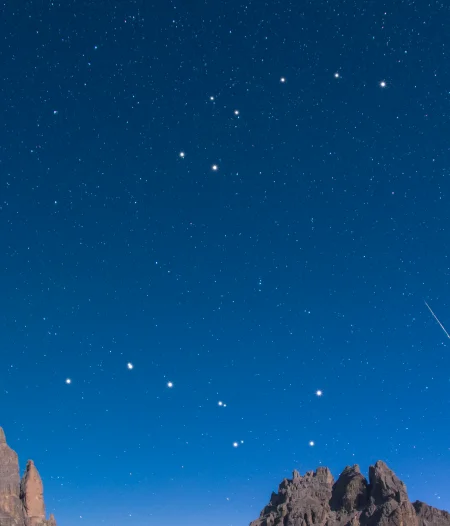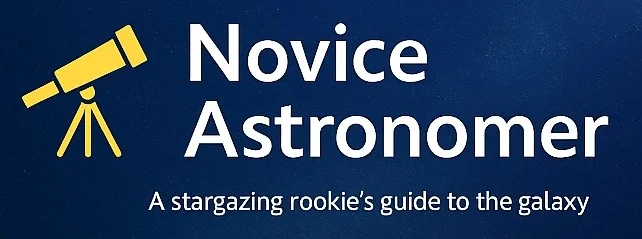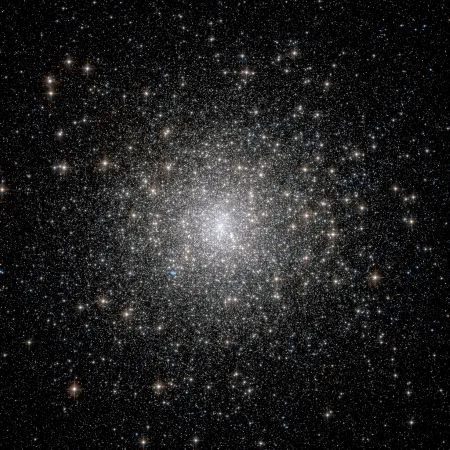I almost didn’t go. I was cozy in my Chewbacca onesie, fully committed to being lazy. But the sky was clear, and Paul—our astronomy club president—was scheduled to give his reportedly excellent beginner sky tour. Something in me said: just go.
It wasn’t my first star party (a casual group stargazing event), but it would be my first chance to experience his tour. I gave myself permission to attend off-duty—no blog post, no note-taking. Just me and the stars.
I ended up learning more than I expected. This isn’t a full-on observing guide—but if you’re new to star parties, here are a few things one night under the sky taught me. Nothing too technical—just a handful of beginner moments, little surprises, and lessons I didn’t expect to come away with.
Polaris = Sky Anchor
One of the first things Paul pointed out was Polaris, the North Star. You can find it by following the line formed by the outer two stars of the Big Dipper’s bowl.
Polaris doesn’t move (much)—everything else in the night sky appears to rotate around it, counterclockwise. You may have learned this in school, like I did, but it never really landed until now.
I finally understood why the Big Dipper is so easy to spot—it’s not just recognizable, it’s practically always up there. Apparently, both the Big and Little Dippers circle Polaris, staying visible year-round from our latitude. In fact, Polaris itself is actually part of the Little Dipper—the star at the very end of its handle.
A Very Special Relationship
Paul also showed us a fun trick: the Big and Little Dippers are always locked in a 6:9 formation, relative to each other. At that time, the Big Dipper looked like a 6 and the Little Dipper a 9. Other times of the night or year, their positions flip—but one will always curve like a 6 and the other like a 9.
No comment.

I hadn’t realized how near the Dippers sit to each other—or how much fainter the Little Dipper’s stars are, with a shape that’s trickier to pick out. It was the first time I felt like the sky had a structure—and that I was finally beginning to see how it worked.
Precession of the Equinoxes
This part blew my mind: Polaris is our North Star now, but it hasn’t always been. Thousands of years ago, Vega held the title—and will again someday. Other stars get their turn too, thanks to a long-term wobble in Earth’s axis known as the precession of the equinoxes.
This is the topic of Skip’s upcoming presentation. Understanding the basics made me even more excited to attend.
It’s wild to think that the sky we take for granted isn’t fixed—it’s slowly shifting, even if we don’t notice it in a single lifetime.
Planet vs. Star: A Beginner’s Dilemma
We spotted Mercury (a rare treat!) and Mars, both near Regulus in Leo. Mercury’s hard to catch because it never strays far from the Sun—it’s usually buried in glare or too low on the horizon to see clearly.
Paul helped us compare how planets and stars appear through a telescope:
- Planets show up as tiny discs in a telescope.
- Stars appear as points of light, even when magnified.
Gary put it similarly—stars stay sharp and small like pinpoints. Between the two of them, I finally started to get it. Sort of.
I personally preferred the view of Mercury through a refractor telescope; it looked clearer to my eyes than through a reflector.
First Look at a Globular Cluster
Paul was excited about a low-sitting globular cluster in Centaurus—Omega Centauri, if memory serves, the brightest one in the sky. I looked through the scope and saw… basically nothing. Just a blur.
I hadn’t touched the focus knob—partly a rookie move, partly nerves about messing up someone else’s scope. But then Veronica showed me a reference image on her iPad, and suddenly it clicked—I understood what I was looking at.
Note: The image at the top of this page isn’t the one Veronica showed me—it’s a public domain photo of a globular cluster, but close enough to show why that visual made things click.
A globular cluster is a dense, spherical collection of hundreds of thousands to millions of stars, all gravitationally bound and orbiting the core of a galaxy. Unlike star-forming regions known as nebulae, these clusters are ancient—among the oldest known structures in the universe, with some dating back over 10 billion years.
What’s the Difference?
Globular clusters and nebulae both look like fuzzy blobs in a telescope—but they’re very different things.
- A globular cluster is a gas-free region where old stars huddle together—a sort of cosmic retirement home.
- A nebula is a luminous cloud of gas and dust where new stars are being born—a stellar nursery.
We didn’t view any nebulae that night, but I’d seen them at previous star parties. Knowing the difference helps this particular blur make a lot more sense.
Later, we viewed another cluster (I didn’t catch which one), and this time I adjusted the focus myself. It popped more clearly, partly because I now knew what to look for.
Takeaway: reference images help, focus knobs matter, and your eyes will get better with practice.
Chasing the Milky Way
We looked toward Sagittarius, which marks the center of the Milky Way. The Milky Way itself was just starting to rise—too faint to really make out—and I didn’t feel like sticking around until 1 a.m. to chase it down.
Gary assured me that next month it’ll be visible earlier in the night. Sometimes the sky makes you wait—and that’s okay.
Update: I finally saw the Milky Way a few weeks later on a trip to Boone—right where Gary said it would be. I wrote about it here. Totally worth the wait.
Classic Noob Moment: The Phantom Not-A-Star
At one point, I spotted a bright white light that wasn’t moving. I knew better than to jump to conclusions—planes are the classic beginner trap—but this one wasn’t blinking, wasn’t shifting, and seemed perfectly still. I gave it time. I even asked aloud, “What is that right there?” A few people glanced up, but no one had a clear answer.
So I opened my Sky Tonight app and focused on that for a bit, trying to line things up and confirm what I was seeing. But by the time I looked back—it was gone.
I stood there, stunned. I had watched it long enough to feel sure it couldn’t be a plane—and then poof.
That’s when Mary explained that when planes are coming head-on, they can look completely stationary until they shift angle and vanish. I’ve made the airplane mistake before—but this one really got me.
What Are the Odds? We Saw a Nova
Veronica tracked down Nova Lupi V462—a new nova in the constellation Lupus—and invited all of us to take a look through her scope. We even managed to image it. Chris saw it with the unaided eye; Paul managed a blurry photo on his phone.
I learned that a nova is a temporary stellar explosion—when a white dwarf flares up after pulling in material from a nearby companion star. Unlike a supernova, it doesn’t destroy the star, so the eruption can actually happen more than once. “New nova” here just means newly discovered during this eruption—not necessarily the star’s first time doing it.
The word nova comes from Latin for “new star,” because ancient astronomers thought they were seeing brand-new stars appear in the sky. In reality, it’s an old star flaring up—briefly stealing the spotlight before fading again.
When I hear Nova, my brain goes straight to Planet of the Apes. Or maybe the Chevy. Turns out the stars had it first. Well, that makes sense. It’s a poetic name that captures the surprise of a sudden brightening where nothing seemed to be before.
A nova can stay bright for days, weeks, or even months—brief by cosmic standards, but long enough to catch if you know where to look.
At the time, I didn’t quite grasp what I was seeing. It felt like just another faint dot in a sky full of them. But looking back… I saw a nova. A literal stellar eruption, visible from Earth. Wow.
Kindness and Connection
As much as I learned from the sky, I learned just as much from the people under it. I didn’t ask many questions out loud that night—at least not compared to my usual rapid-fire mode. But when I did, people were kind.
- When I admitted I was nervous about adjusting someone else’s focus knob, folks reassured me it was okay to try—and encouraged me to practice. I still don’t know which way to turn it (or how far), but knowing it’s okay to mess up made me feel more welcome than worried.
- When I asked aloud about a strange light in the sky, nobody brushed it off or made me feel silly. They looked. They listened. And when it turned out to be a head-on plane, Mary gently explained how easy that mistake is—and why it happens.
- Veronica didn’t just show us what was in the telescope—she pulled up a reference image to help me understand what I was seeing. That moment flipped a switch in my brain. It turned a blurry blob into a visual with meaning.
That kind of low-key encouragement was one of the best parts of the night for me. Nobody made a big deal out of mistakes or confusion. There was no pressure, no judgment—just people quietly helping each other learn.
We spotted Mercury in the western twilight, compared it to Mars, tracked down a nova, and capped it off with Astro 101 under beautifully clear skies. What a treat!
— Paul, Club Email Recap
Final Reflection: Why This Night Mattered
I didn’t take notes. I didn’t plan to write about it. I almost didn’t go. But I gave myself the space to just show up—and the sky delivered.
If you’re new to star parties, know this: you won’t understand everything. You’ll miss things. You’ll mistake a plane for something amazing and forget which way the focus knob turns. But that’s part of it. You learn. You laugh at yourself. And if you’re lucky, you leave with a little more wonder than you arrived with.
That night, I happened to roll out of the parking lot at exactly 11:11 p.m.
Cosmic approval, I’d like to think.


What a clear, awesome description of what you saw! It makes me want to go to the next star party. Great article!
Thanks so much, Lisa—that would be great! I really enjoyed putting this together, Paul’s tour gave me a strong foundation to build on.